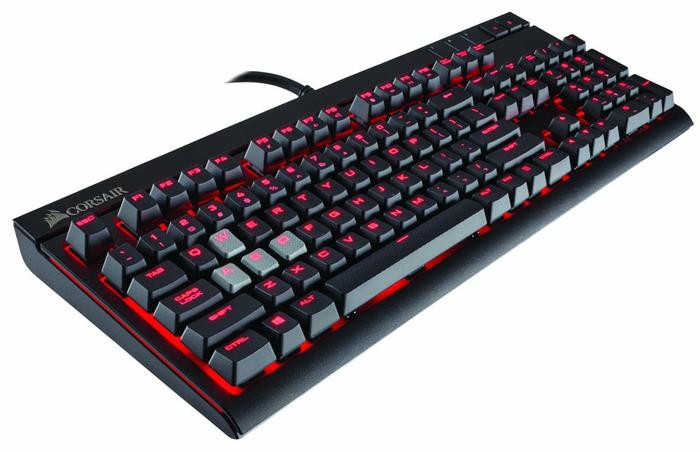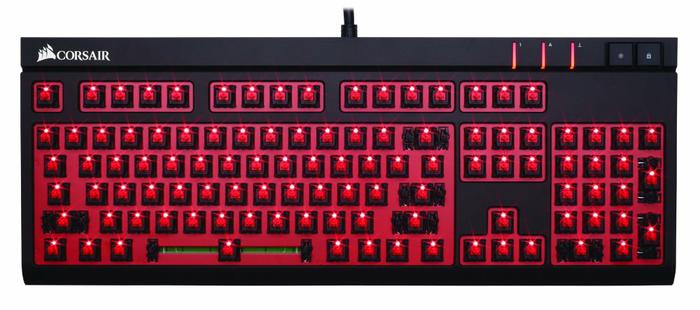Introduction and design
Mechanical keyboards are all the rage these days among PC users, gamers and non-gamers alike, as there's just something incredibly rewarding about owning and using a mechanical keyboard that's difficult to pin down. As mechanical keyboards have risen to prominence among the PC audience Corsair has been at the forefront of that trend. Corsair has been first to market with new Cherry MX switches such as with the MX RGB and MX Silent switches, both of which were granted to Corsair for a timed exclusive period by Cherry.
As Corsair's range of mechanical gaming keyboards has expanded new models have been introduced to cater for different users and price points, the latest of which is the Strafe. Under the slogan 'Real Mech or Nothing' the Strafe joins the K30, K40, K65 RGB, K70, K70 RGB and K95 RGB in Corsair's current gaming keyboard range. The Strafe acts as the entry model for Corsair's mechanical keyboards with an MSRP of $110 that sits just below the K70 single-colour ($120) and K70 RGB ($155) models, the newly-announced and upcoming Strafe RGB available with MX Silent switches should shake things up a bit too.
Corsair takes a slightly simpler approach with its Strafe keyboard versus the K70 RGB which reflects in the few key differences between the models, although, the two keyboards end up being fairly similar. In terms of similarities the Corsair Strafe comes with MX Blue (available later this year), Brown and Red key switch options, just like the K70 (RGB), it also comes with the same full-sized keyboard layout and there are no dedicated macro buttons on either, such a feature is reserved for the K95 (RGB). N-Key rollover is supported up to 104 keys, which equates to the entire keyboard, on both the Strafe and K70, as well as a USB pass-through and individual per-key programmable lighting with the CUE software.
Where the two keyboards differ is in terms of LED options, the Strafe is available in LED Red only while the K70 can be found in LED Blue or Red and the K70 RGB has a full 16.8 million colours available. Media keys vary slightly as well with the Strafe having shortcuts made available through seven FN and function key combinations, e.g. FN + F11 is play/pause, while the K70 and K70 RGB have six dedicated buttons for media control. Both keyboards have dedicated brightness and Windows lock keys.
The Corsair Strafe ditches the rubber-coated wrist-rest in favour of a more compact design and uses a plastic chassis rather than the anodised aluminium chassis found on the K70 and K70 RGB. Another aesthetic change is that the Corsair Strafe uses the newest iteration of Corsair's Sails logo by default, rather than the Corsair Gaming logo found on most Corsair Gaming versions of the Vengeance K70 and K95 RGB.
Corsair is currently in the process of rolling out the new Sails logo to all its gaming keyboards, users will have to be cautious about which stock they are buying if the logo is an important purchase consideration. This decision to reinstate the Sails logos, albeit an updated variant, on Corsair's gaming products comes after somewhat hostile feedback from the PC community to the Corsair Gaming logo that resulted in a change.org petition and a number of angry forum users.
There are also software variations between the Strafe and K70 single-colour worth considering. Notably, the fact that the K70 non-RGB model doesn't support programmable keys, per-key lighting control or the CUE software in any capacity. For all intents and purposes the Strafe is pitched as an alternative to the K70 rather than K70 RGB, which has all the same advanced CUE features of the Strafe but with extras like the wrist rest and dedicated media keys for good measure.
Prospective Corsair mechanical keyboard buyers at the $100-$120 price point have to make the appropriate trade-offs between the Strafe, which has a lower cost, macro and per-key customisation, and the K70, which has premium materials, a wrist-rest and dedicated media buttons. The Strafe also comes with sets of interchangeable keycaps and a keycap puller for the QWERDF and WASD keys, tailored for the MOBA and FPS audiences, respectively.












